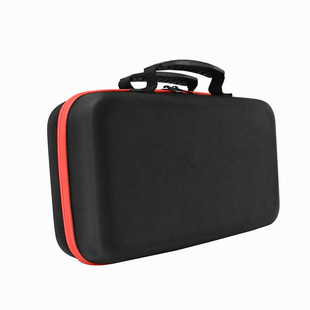Photography Equipment EVA Bag Buying Guide
For professional photographers, lenses, camera bodies, flashes, and other equipment are not just creative tools but also long-term investments. The bumps and bumps of outdoor shooting, the moisture from rainy weather, and the scratches from frequent storage can all damage valuable equipment. An appropriate EVA bag is the key to addressing these pain points. This article will analyze the purchasing logic of an EVA bag for photography equipment based on professional needs, helping international buyers find the ideal option that balances protection, adaptability, and portability.
I. Purchasing Prerequisites: Clarify Your Core Needs and Avoid Blindly Adapting
Professional photography scenarios vary greatly. Commercial studio photography, outdoor landscape photography, and travel documentary photography require completely different equipment configurations and usage environments. The first step is to clarify your needs to accurately match your toolkit:
1. Organize Your Equipment List: Use “Size + Weight” as a Basis
First, list the detailed specifications of your commonly used equipment, including:
Core Equipment: Camera body (full-frame/crop-frame), lens (fixed-focus/zoom; for example, a 70-200mm telephoto lens requires separate length consideration), flash/flash trigger, monitor, etc., recording the maximum dimensions (length × width × height) and total weight.
Accessory Details: The number of small items such as batteries, memory cards, filters, and cleaning kits, including the number of batteries, memory cards, filters, and cleaning kits, should be determined, and whether separate storage space is required.
Special Needs: If you are bringing a drone gimbal, action camera, etc., you will need to reserve additional custom slots. For example, outdoor landscape photographers often carry two cameras, three lenses, and a tripod head. Their tool bag must accommodate lenses at least 35cm in length and hold 5-8kg. Commercial still life photographers, on the other hand, focus on multiple lenses and lighting systems, requiring a layered and compartmentalized design.
2. Targeting the Use Scenario: Determining Protection Levels Based on “Environmental Risks”
The protection requirements for EVA tool bags vary significantly depending on the scenario. These requirements can be categorized by the following scenario types:
Harsh outdoor environments (mountains, deserts): Focus on drop resistance (EVA density ≥ 50D), sand resistance (sealed zippers), and abrasion resistance (outer Oxford fabric ≥ 600D);
Wet environments (rainforests, coastal areas): Waterproofing is essential (TPU coating on the fabric + waterproof zippers, capable of withstanding brief periods of rain);
Urban portable use (street photography, conferences): Prioritize lightweight (total weight ≤ 1.2kg), minimalist design, and a quick lens release port (magnetic/side-opening).
3. Determine the balance between capacity and portability.
Avoid overly large or undersized bags: Too little capacity will squeeze your gear, while too much will increase the burden. We recommend choosing a bag based on “common gear + 10% extra space”—for example, if you’re carrying one camera, two lenses, and accessories daily, choose a 15-20L capacity; if you’re carrying three cameras, four lenses, and a lighting system for long-distance shoots, choose a 25-30L capacity. Also, consider design considerations for portability, such as a detachable shoulder strap (for single- or dual-shoulder use), reinforced handles (to prevent deformation from prolonged carrying), and a design that can be attached to a suitcase handle (suitable for international travel).
II. Core Parameters: Determine the “Professionalism” of an EVA Bag Based on Three Key Dimensions
The properties of the EVA material determine the bag’s protective capabilities, but not all “EVA bags” are compatible with photographic equipment. A thorough assessment should be made based on the following three core dimensions:
1. Protective Performance: EVA Density and Structure Are Key
EVA Density: Density directly impacts drop resistance and cushioning capabilities. EVA bags specifically designed for photographic equipment should have a density between 40D and 80D (regular EVA bags are typically 30D or less, offering insufficient protection). Specifically:
40D-50D: Suitable for everyday, light protection (such as indoor storage and short-distance urban travel), capable of withstanding a 1-meter drop;
60D-70D: Suitable for medium-to-high-intensity protection (outdoor photography and long-distance transportation), capable of withstanding a 1.5-meter drop and a 5kg impact;
80D and above: For heavy equipment (such as telephoto lenses and movie cameras), custom thickened EVA layers (≥15mm) can be added to meet the needs of professional film and television crews. Cushioning Structure Design: A single EVA layer provides limited protection, so high-quality tool bags utilize a multi-layer composite structure:
Outer layer: Abrasion-resistant fabric (Oxford cloth/nylon) + waterproof coating to protect against external scratches and rain;
Middle layer: EVA cushioning layer (customized grooves tailored to the shape of the equipment to reduce vibration). Some high-end models incorporate honeycomb EVA for improved cushioning;
Inner layer: Soft flocking/suede to protect equipment surfaces (especially lens coatings and body paint) from scratches.
Sealing and waterproofing: Two essential indicators for outdoor use: ① Fabric waterproofness rating (must be IPX3 or higher, meaning it can withstand water jets at a 60° angle); ② Zipper type (prefer YKK waterproof zippers over standard nylon zippers to prevent water from seeping through gaps).
2. Structural Design: “Partitioning + Customization” Determines Efficiency
Professional photographers place high demands on storage efficiency in their tool bag. An inappropriate structure can lead to slow lens access and equipment clutter. Consider the following:
Reasonable Partitioning:
Main Compartment: Must have adjustable EVA dividers (≥5mm thick, with freely adjustable slots) to accommodate lenses and camera bodies of varying sizes and prevent collisions.
Sub-Compartments: Must be divided into a “Quick Access Sub-Compartment” (outside compartment for commonly used accessories such as batteries and memory cards, secured with an elastic strap) and a “Hidden Sub-Compartment” (inside compartment for filters and cleaning cloths to prevent dust ingress).
Special Compartments: For valuable accessories, separate shockproof compartments are required (such as lens filter compartments and waterproof memory card holders). Some models may feature a tripod strap (outside or side compartment, with a load capacity of ≥3kg). Customizable Slots: If you have a fixed gear combination (e.g., Sony A7M4+24-70mm+70-200mm), prioritize brands that offer customizable EVA liners. These feature laser-cut EVA grooves to perfectly fit the gear’s contours, minimizing movement to less than 1cm. (Regular, universal models often experience movement of 3-5cm, potentially damaging the gear.)
Opening/Closing Method: Choose based on your shooting habits:
Full-Top Opening: Ideal for quick access to all gear (e.g., changing lenses in studio shoots). Requires a magnetic and zippered closure for security.
Side-Opening: Ideal for quick access to a single lens (e.g., candid outdoor shoots). Side-opening compartments should have reinforced buckles to prevent accidental opening.
Clamshell: Combines protection and convenience. Inside the flap, you can design an accessory pocket for storing multiple gear. 3. Material Details: Small Components Determine Durability
Exterior Fabric: In addition to being waterproof, it must be abrasion-resistant and tear-resistant. We recommend 600D Oxford cloth (a general choice, durable and lightweight) or 1680D nylon (for high-intensity scenes, such as frequent outdoor shooting). The fabric must pass the Martindale Abrasion Test (≥10,000 revolutions to ensure long-term snagging resistance).
Lining Material: Prefer flocking or suede (softness ≥300g/m²). Avoid ordinary synthetic fabrics (which can generate static electricity, attract dust, and damage lens coatings).
Accessory Quality:
Zippers: Look for brands such as YKK and SBS. They must be able to be pulled at least 5,000 times without catching.
Fasteners: Shoulder strap buckles and bulkhead buckles must be made of nylon (low-temperature resistant, no cracking at -20°C, suitable for shooting in cold climates).
Stitching: Stitch density ≥12 stitches/ Key areas (such as handles and shoulder strap joints) require double reinforcement to prevent breakage.
III. Practical Tips: 4 Steps to Avoid Pitfalls and Verify the “True Performance” of a Tool Bag
International buyers cannot inspect the product in person, so they must verify details and match their needs to avoid pitfalls:
1. Request a “Protection Test Report”
Professional manufacturers will provide third-party test reports, focusing on three key data points:
Drop Test: 1.5-meter free fall (simulating an outdoor drop), no scratches or functional damage to the internal equipment;
Waterproof Test: IPX3 or higher spray test (5 minutes, no water seepage);
Load Test: After the tool bag is fully loaded (according to the marked capacity), the shoulder strap hangs for 24 hours, with no deformation or seam breakage.
If the manufacturer cannot provide a report, choose with caution—low-quality EVA bags may be made from recycled EVA material, which has uneven density and unstable protective performance.
2. Verify “Dimensional Compatibility”
Don’t just look at the listed capacity. Ask the manufacturer for the “actual internal dimensions” (main compartment length × width × height) and compare them to the maximum dimensions of your equipment. For example, a 70-200mm lens is approximately 20cm long, so the main compartment should be ≥ 22cm long (allowing a 2cm buffer) to avoid a situation where the lens fits but is squeezed. If you have specialized equipment (such as telephoto lenses or cinema cameras), ask the manufacturer for a custom drawing to confirm that the slot dimensions match exactly.
3. Focus on “International Certifications and Compliance”
For export, products must meet the compliance requirements of the target market to avoid customs clearance issues:
Environmental certifications: RoHS (Restriction of Hazardous Substances, suitable for European and American markets), REACH (EU Chemical Compliance);
Safety certifications: CE (EU safety standards), FCC (US Electromagnetic Compatibility, required for tool kits with charging modules);
Material certifications: OEKO-TEX® (lining fabric is formaldehyde- and heavy metal-free to prevent contamination from contact with equipment).
4. Avoid 3 Common Misconceptions
Misconception 1: “Heavier is better” – Excessive weight increases the burden of carrying. High-quality EVA bags achieve a balance between protection and weight by optimizing EVA thickness and lightweight fabric (for example, a 20L tool bag weighs 1-1.3kg).
Misconception 2: “Only focus on appearance, ignoring details” – Some bags may appear exquisite, but zippers can easily get stuck or dividers can easily deform. Pay attention to accessory brands (such as YKK zippers) and EVA hardness (high-quality EVA will rebound quickly and not dent when pressed).
Misconception 3: “Universal models are more cost-effective” – Universal models don’t conform to the shape of photographic equipment and are prone to wear and tear from shaking. Customized EVA liners, while slightly more expensive, offer better protection for equipment (especially valuable lenses) and reduce repair costs in the long run.
IV. Scenario-Specific Recommendations: Suitable Options for Different Photographers
1. Outdoor Landscape Photographers: Highly Protected + Portable
Core Requirements: Drop-Resistant, Waterproof, and Tripod Compatible
Recommended Features: 60D EVA Density + IPX4 Waterproof + 1680D Nylon Outer Layer, 25L Capacity, Adjustable Main Compartment Divider (Compatible with 2 Cameras and 3 Mirrorless Cameras), External Tripod Strap, and Pressure-Reducing Sponge Shoulder Straps (Relieves Pressure During Long-Term Carrying).
Suitable Scenes: Mountain, Coastal, and Rainforest Shooting. Withstands brief downpours and drops from 1.5 meters.
2. Commercial Still Life Photographers: Multi-Layer Partitioning + Customizable
Core Requirements: Multi-gear storage, quick lens access, customizable slots
Recommended Configuration: EVA-density 50D with full-opening top closure, 30L capacity, 3-layer main compartment (camera, lens, and lighting), hidden filter compartment (holds 6 filters), and customizable EVA liner to fit commonly used equipment.
Suitable Scenes: Studio and product photography, allowing for quick lens and lighting changes without equipment clutter.
3. Travel and Documentary Photographers: Lightweight + Versatile
Core Requirements: Portability, Multi-Scene Adaptability, and Expandability
Recommended Configuration: EVA density 40D + Weight ≤ 1.2kg, 18L capacity (expandable to 22L), external luggage trolley adaptability, single-shoulder/double-shoulder carry, and quick-access auxiliary compartment for memory cards and batteries.
Suitable Scenes: Urban street photography, international travel, balancing portability and storage needs, and adaptable to various modes of transportation.
Conclusion: Choosing the Right EVA Bag Makes Your Gear a “Reliable Partner”
For professional photographers, an EVA bag is more than just a storage container; it serves as a protective barrier for your gear and a creative tool. When purchasing, focus on key specifications based on your needs, paying attention to “protective performance,” “structural design,” and “detailed quality.” Prioritize brands with international certifications and support for customization. Such EVA bags will protect your gear in various shooting scenarios and improve your creative efficiency.
Post time: Oct-27-2025





